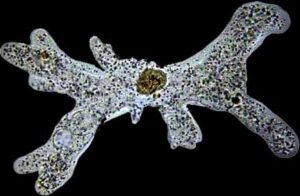- जीवाणु की खोज सर्वप्रथम किसने की थी? = ल्यूवेनहॉक.
- एक स्वस्थ मनुष्य का रक्त चाप होता है? = 120/80.
- रक्त में ग्लूकोज की मात्रा को कौन नियंत्रित करता है? = इंसुलिन.
- नियततापी प्राणी (Warm-Blooded Animal) कौन है? = चमगादड़ एवं अन्य स्तनधारी और पक्षी वर्ग.
- मनुष्य की खोपड़ी में कितनी अस्थियां होती है? = 22 हड्डियां.
- रक्त में लाल रंग किसके कारण होता है? = हीमोग्लोबिन.
- एन्टीजन (Antigen) एक ऐसा पदार्थ है जो? = प्रतिरक्षी के निर्माण को बढ़ावा देता है.
- अमीबा किस की मदद से भोजन ग्रहण करता है? = पादाभ (Pseudopodia).
- मनुष्य में एफ्लाटाक्सिन खाद्य विषाक्त द्वारा सामान्यतः कौन सा अंग प्रभावित होता है? = यकृत.
- पीयूष ग्रन्थि शरीर में किस स्थान पर स्थित होती है? = मस्तिष्क के आधार में.
- पित्त आसव (Bile juice) किसमे संग्रहित रहता है ? = पित्ताशय (Gall bladder).
- हॉर्मोन शब्द का नामकरण किसने किया था? = बेलिस एवं स्टारलिंग.
- पेट में भोजन को पचाने के लिये किसकी खास आवश्यकता होती है? = एन्जाइम.
- मुख से निकली लार (Saliva) किसका पाचन करती है? = स्टार्च (Starch).
- किस अम्ल की उपस्थित मानव पेट में होती हैं? = हाइड्रोक्लोरिक अम्ल.
- पाचन क्रिया में प्रोटीन (Protein) किस पदार्थ में बदल जाता है? = एमीनो अम्ल(Amino acids).
- वह अंग कौन सा है जो मानव शरीर में ग्लाइकोजेन के रूप में कार्बोहाइड्रेट को जमा कर रखता है? = यकृत (Liver).
- पित्त किसके द्वारा पैदा होता है? = यकृत(Liver).
- मनुष्य के शरीर में हृदय को एक बार धड़कने के लिये कितना समय लगता है? = 0. 8 सेकंड्स.
- स्वस्थ्य मनुष्य (Human Body) में प्रति मिनट हृदय स्पन्दन(Heartbeat) होता है? = 72 बार.
- स्वस्थ्य मनुष्य का रक्त चाप (सिस्टालिक (Systolic) व डाइस्टालिक (Diastolic) होता है? = 120 एम.एम व 80 एम.एम.
- मनुष्य में कुल कितनी हड्डियां (Bones) होती है? = 206.
- जीन कहां स्थित होते हैं? = गुणसूत्रों में.
- वायरस से फैलने वाला रोग हैं? = चेचक.
- कौन सा रोग बैक्टीरिया के कारण होता है? = तपेदिक (Tuberculosis).
डॉ, (प्रो.) अमरेंद्र कुमार
========== ========= ===========
Related to Biology-146.

- Who discovered bacteria first? = Leeuwenhoek.
- Blood pressure of a healthy human being is? = 120/80.
- Who controls the amount of glucose in the blood? = Insulin.
- Who is a warm-blooded animal? = Bat and other members of mammals and Aves (birds).
- How many bones are there in the human skull? = 22 bones.
- Red colour in blood is due to? = Haemoglobin.
- Antigen is a substance which? = Promotes the formation of antibodies.
- Amoeba consumes food with the help of? = Pseudopodia.
- Which organ is generally affected by aflatoxin food poisoning in humans? = Liver.
- At which place in the body is the pituitary gland located? = At the base of the brain.
- Bile juice is stored in? = Gall bladder.
- Who coined the term hormone? = Bellis and Starling.
- What is required to digest food in the stomach? = Enzyme.
- What does the saliva that comes out of the mouth digest? = Starch.
- Which acid is present in the human stomach? = Hydrochloric acid.
- In the process of digestion, protein is converted into which substance? = Amino acids.
- Which is the organ that stores carbohydrates in the form of glycogen in the human body? = Liver.
- Bile is produced by? = Liver.
- How much time does it take for the heart to beat once in a human body? = 0.8 seconds.
- In a healthy human body, the number of heartbeats per minute is? =72 times.
- The blood pressure (systolic and diastolic) of a healthy human is? = 120 mm and 80 mm.
- How many bones does a human have? = 206.
- Where are genes located? = In chromosomes.
- Which disease is spread by viruses? = Smallpox.
- Which disease is caused by bacteria? = Tuberculosis.
Dr. (Prof.) Amarendra Kumar
|


